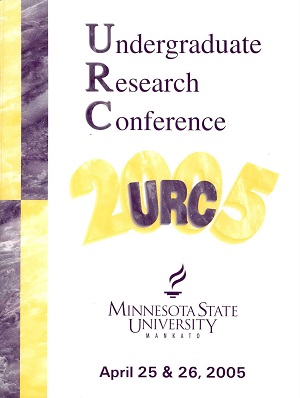Bank Sloughing Contributions to Fluvial Suspended Sediment in the Blue Earth River, Blue Earth County, Minnesota
Location
CSU 253
Start Date
26-4-2005 10:00 AM
End Date
26-4-2005 12:00 PM
Student's Major
Chemistry and Geology
Student's College
Science, Engineering and Technology
Mentor's Name
Bryce Hoppie
Mentor's Department
Chemistry and Geology
Mentor's College
Science, Engineering and Technology
Description
The Minnesota River is a federally declared impaired river. One of the main causes of its impairment is the volume of entrained clay-sized suspended sediment it carries. The Blue Earth River is identified as the largest contributor of sediment to the Minnesota River. There are two sources of sediment in the Blue Earth River. One source is from run off of fields and public/private ditches. The other source is from slump failure (i.e., sloughing) of slopes along the Blue Earth River. Recent research indicates that up to 75% of the total suspended load may come from bank sloughing. This research tested the sloughing theory by analyzing grain size distribution along a bank of the Blue Earth River near Vernon Center, Minnesota. Twelve samples weighing over 2 kg each were collected from vertical and horizontal transects across the exposed bank. Sieve and settling tube techniques were used to analyze grain size. Results were plotted on a panel of photographs, and proportions of clay were mapped spatially along the bank. Total clay content was calculated for each area. Preliminary results conclude that the bank is mostly sandy in composition. Total clay content for this bank is less than 15% of the total sediment. Thus, for the site, results indicate bank sloughing is a minor contributor of suspended sediment to the Blue Earth River (and ultimately the Minnesota River).
Bank Sloughing Contributions to Fluvial Suspended Sediment in the Blue Earth River, Blue Earth County, Minnesota
CSU 253
The Minnesota River is a federally declared impaired river. One of the main causes of its impairment is the volume of entrained clay-sized suspended sediment it carries. The Blue Earth River is identified as the largest contributor of sediment to the Minnesota River. There are two sources of sediment in the Blue Earth River. One source is from run off of fields and public/private ditches. The other source is from slump failure (i.e., sloughing) of slopes along the Blue Earth River. Recent research indicates that up to 75% of the total suspended load may come from bank sloughing. This research tested the sloughing theory by analyzing grain size distribution along a bank of the Blue Earth River near Vernon Center, Minnesota. Twelve samples weighing over 2 kg each were collected from vertical and horizontal transects across the exposed bank. Sieve and settling tube techniques were used to analyze grain size. Results were plotted on a panel of photographs, and proportions of clay were mapped spatially along the bank. Total clay content was calculated for each area. Preliminary results conclude that the bank is mostly sandy in composition. Total clay content for this bank is less than 15% of the total sediment. Thus, for the site, results indicate bank sloughing is a minor contributor of suspended sediment to the Blue Earth River (and ultimately the Minnesota River).



